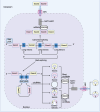CircRNAs: functions and emerging roles in cancer and immunotherapy
- PMID: 40817061
- PMCID: PMC12357350
- DOI: 10.1186/s12916-025-04306-5
CircRNAs: functions and emerging roles in cancer and immunotherapy
Abstract
Background: Circular RNAs (circRNAs) are emerging as promising tools in cancer and immunotherapy, with unique characteristics that offer potential therapeutic applications.
Main body: This review outlines the discovery, biogenesis, and mechanisms of circRNAs, emphasizing their roles in cancer and immune regulation. CircRNAs modulate immune responses by acting as miRNA sponges, binding RNA-binding proteins, or serving as translation templates. These interactions influence T cells, NK cells, macrophages, and immune checkpoints. The review also explores circRNAs' roles in different cancers, focusing on target identification, immune effects, and mechanisms of action. Additionally, it examines circRNA-based therapies, including vaccines, CAR-T cell therapy, and database applications.
Conclusion: Despite their potential, technical hurdles must be overcome to advance circRNAs' clinical use in cancer immunotherapy. Future research should focus on addressing these challenges to fully realize the therapeutic potential of circRNAs.
Keywords: Biomarkers; Cancer; CircRNAs; Immunotherapy; Tumor vaccines.
© 2025. The Author(s).
Conflict of interest statement
Declarations. Ethics approval and consent to participate: N/A. Consent for publication: N/A. Competing interests: The authors declare no competing interests.
Figures



References
-
- Hansen TB, Jensen TI, Clausen BH, Bramsen JB, Finsen B, Damgaard CK, et al. Natural RNA circles function as efficient microrna sponges. Nature. 2013;495(7441):384–8. - PubMed
Publication types
MeSH terms
Substances
Grants and funding
LinkOut - more resources
Full Text Sources
Medical

